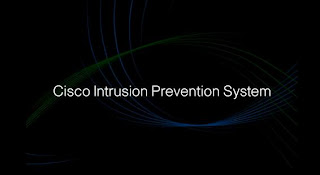Network Security Notes: Cisco Intrusion Prevention System-Cisco IPS
This blog is created for network security review, study and understanding about network related issues only!
The blog is mainly focus on Network Security Notes about Network, Network Security, Network Technology, Network Labs review related Cisco and Microsoft technology ,Network Threats, Types of Network Threats, Network Alerts, Enterprise Security Policy and Audits, Security Policy and Audits,Logical Security, Physical and Logical Security, Physical Security,Cisco Products Review, Microsoft Products review, Cisco Routers, Routers Security, Console Access, Telnet Access, Network Attack, Network Attack report, Network management, Anti-virus, Network Security with Anti-virus, and All About Network Security... Thanks for your visit!
Network Security Notes: Cisco Intrusion Prevention System (Cisco IPS)
In this post, I would like to share with you a very great important video regarding network security in the Cisco IPS.
Before you learn the video about the Cisco IPS, you should know what IPS is...
What is Intrusion Prevention System-IPS?
Intrusion Prevention Systems (IPS), also known as Intrusion Detection and Prevention Systems (IDPS), are network security appliances that monitor network and/or system activities for malicious activity. The main functions of intrusion prevention systems are to identify malicious activity, log information about said activity, attempt to block/stop activity, and report activity.
Intrusion prevention systems are considered extensions of intrusion detection systems because they both monitor network traffic and/or system activities for malicious activity. The main differences are, unlike intrusion detection systems, intrusion prevention systems are placed in-line and are able to actively prevent/block intrusions that are detected. More specifically, IPS can take such actions as sending an alarm, dropping the malicious packets, resetting the connection and/or blocking the traffic from the offending IP address. An IPS can also correct Cyclic Redundancy Check (CRC) errors, unfragment packet streams, prevent TCP sequencing issues, and clean up unwanted transport and network layer options.
IPS Classifications:
Intrusion prevention systems can be classified into four different types:
Network-based Intrusion Prevention (NIPS): monitors the entire network for suspicious traffic by analyzing protocol activity.
Wireless Intrusion Prevention Systems (WIPS): monitors a wireless network for suspicious traffic by analyzing wireless networking protocols.
Network Behavior Analysis (NBA): examines network traffic to identify threats that generate unusual traffic flows, such as distributed denial of service (DDoS) attacks, certain forms of malware, and policy violations.
Host-based Intrusion Prevention (HIPS): an installed software package which monitors a single host for suspicious activity by analyzing events occurring within that host.
How the IPS Detection methods work?
The majority of intrusion prevention systems utilize one of three detection methods: signature-based, statistical anomaly-based, and stateful protocol analysis.
Signature-based Detection: This method of detection utilizes signatures, which are attack patterns that are preconfigured and predetermined. A signature-based intrusion prevention system monitors the network traffic for matches to these signatures. Once a match is found the intrusion prevention system takes the appropriate action. Signatures can be exploit-based or vulnerability-based. Exploit-based signatures analyze patterns appearing in exploits being protected against, while vulnerability-based signatures analyze vulnerabilities in a program, its execution, and conditions needed to exploit said vulnerability.
Statistical Anomaly-based Detection: This method of detection baselines performance of average network traffic conditions. After a baseline is created, the system intermittently samples network traffic, using statistical analysis to compare the sample to the set baseline. If the activity is outside the baseline parameters, the intrusion prevention system takes the appropriate action.
Stateful Protocol Analysis Detection: This method identifies deviations of protocol states by comparing observed events with “predetermined profiles of generally accepted definitions of benign activity.”
In the video you will learn three main points about the Cisco IPS: Threat Intelligence, Advanced Inspection Protection, Repulation Technology.
Why the IPS of Cisco?
As I think, Cisco is the king company in producing network devices products. The world's using Cisco Routers, Cisco Switch.....
As you know, new threats and vulnerabilities present challenges to network security. Cisco intrusion prevention systems use global threat intelligence to help meet these challenges. Learn more about Cisco IPS solutions...
** Cisco Intrusion Prevention System:
Security is ever changing...
New Vulnerabilities...
New Vectors...
Zero Day Threats...
How do we solve this?
...from complexity to simplicity
It's more than just strength...Speed Agility and Intelligence.
Other sites you may want to see:
Entertainment on Flixya: http://visalittleboy.flixya.com/
WWE: http://visa-wwe.blogspot.com/
The Kingdom of Wonder: http://welcome2cambodia.blogspot.com/
Daily Blogging: http://visablogging.blogspot.com/
Love Sharing: http://visa-love.blogspot.com/
NetworkSecurity: http://networksecuritynotes.blogspot.com/
About Insurance:http://visa-insurance.blogspot.com
All about Love: http://visa-love.blogspot.com/
Learning English Online: http://visa-elb.blogspot.com/
Discovery Internet: http://visa-isp.blogspot.com/








 Cisco Intrusion Prevention System-Cisco IPS
Cisco Intrusion Prevention System-Cisco IPS 
0 comments:
Post a Comment